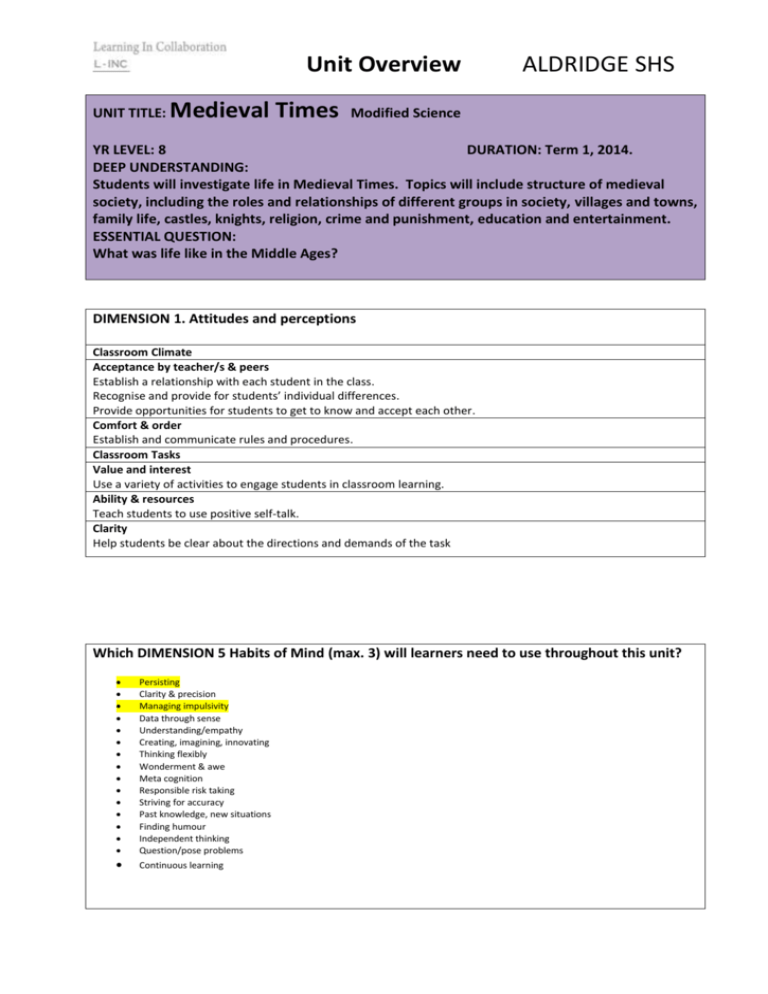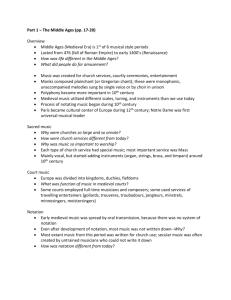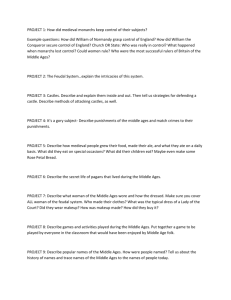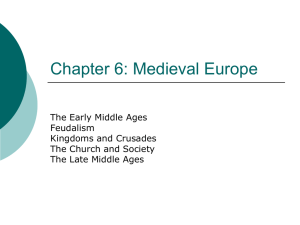M8.1 Medieval
advertisement

Unit Overview UNIT TITLE: Medieval Times ALDRIDGE SHS Modified Science YR LEVEL: 8 DURATION: Term 1, 2014. DEEP UNDERSTANDING: Students will investigate life in Medieval Times. Topics will include structure of medieval society, including the roles and relationships of different groups in society, villages and towns, family life, castles, knights, religion, crime and punishment, education and entertainment. ESSENTIAL QUESTION: What was life like in the Middle Ages? DIMENSION 1. Attitudes and perceptions Classroom Climate Acceptance by teacher/s & peers Establish a relationship with each student in the class. Recognise and provide for students’ individual differences. Provide opportunities for students to get to know and accept each other. Comfort & order Establish and communicate rules and procedures. Classroom Tasks Value and interest Use a variety of activities to engage students in classroom learning. Ability & resources Teach students to use positive self-talk. Clarity Help students be clear about the directions and demands of the task Which DIMENSION 5 Habits of Mind (max. 3) will learners need to use throughout this unit? Persisting Clarity & precision Managing impulsivity Data through sense Understanding/empathy Creating, imagining, innovating Thinking flexibly Wonderment & awe Meta cognition Responsible risk taking Striving for accuracy Past knowledge, new situations Finding humour Independent thinking Question/pose problems Continuous learning Unit Overview ALDRIDGE SHS Habit of Mind Contextualised statement (how will this HoM be used in this unit?) Persisting Persevering with tasks to completion Managing impulsivity Take your time! Thinking before acting: remaining calm, thoughtful and deliberative Which DIMENSION 4 Complex Reasoning Process/es will learners USE MEANINGFULLY to demonstrate knowledge and complete the tasks in this unit? Only include relevant activities. Decision Making Problem Solving Invention Experimental Inquiry Investigation Systems Analysis Historical - Students will investigate life in the Medieval Times. Unit Overview ALDRIDGE SHS Which DIMENSION 3 Complex Reasoning Process/es will learners use to EXTEND AND REFINE THIS KNOWLEDGE? Only include relevant activities Comparing Students will compare Medieval times to present times. Classifying Inductive Reasoning Constructing support Analysing perspectives Analysing Errors Deductive Reasoning Abstracting ASSESSMENT - How will I capture and record the knowledge, processes and skills that need to be taught and learnt in the context of the DEEP UNDERSTANDING, ESSENTIAL QUESTION and FOCUS QUESTIONS of this unit? Summative Instruments / Items Formative assessment /Feedback to scaffold task Other assessment tools and instruments ITEM 1 A detailed account of an average day in the life of a villein to inform the reader of what a peasant’s life was like. Participation in class discussions Completion of short tasks Short answer tests ITEM 2 Make a fact sheet about a chosen topic Eg castles, knights, women or a famous person FOCUS QUESTIONS (DIM 2) unpack the DEEP UNDERSTANDING and expand on the ESSENTIAL QUESTION, highlighting key knowledge and understanding that will drive teaching and learning in the unit When was the Medieval Era? What was the structure of medieval society? What is feudalism? What were castles built from, why and where were they built? What was a knight’s life like in the medieval ages? What was life like for villages and towns in the medieval ages? What was life like for women in the Middle Ages? What punishment was used for crimes committed? What was the education and medicine like in the medieval ages? What was life like for the villeins and their families? How powerful was the church? Unit Overview ALDRIDGE SHS KNOWLEDGE FOCUS – Dims 2, 3 & 4 (state specific knowledge in relation to content and process) (including Literacy) Declarative knowledge Procedural knowledge (what facts and information do students need to know to be successful in the unit?) (what skills and processes do students need to be able to use to be successful in the unit?) Knowledge and understanding of social and environmental concepts and facts. Communication of Social and Environmental Ideas. Taking notes Write sentences from notes Writing facts Identifying the origin and purpose of primary and secondary sources Writing paragraphs Identifying and locating sources, using ICTs and other methods Reading a timeline Sequencing historical events, developments and periods Using a range of communication forms (oral, graphic, written) and digital technologies Using historical terms and concepts Completing mind maps and other graphic organisers Developing texts, particularly descriptions and explanations that use evidence from a range of sources Specific Student Needs and Adjustments Specific student Needs, adjustments and considerations Learning difficulties (LD) Summaries of lessons in note form Intellectual Disability (ID) Highlighting information on sheets Speech Language Impairment (SLI) Information broken down into smaller parts Teacher Aide assistance Visual support where possible to assist with learning Autistic Spectrum Disorder (ASD) Unit Overview ALDRIDGE SHS Model written responses with students identifying the patterns of change over time. Unit timetable – (weekly overview – brief detail only – use to determine time frame etc.) Resources “Discovering the Medieval World” by Guest, Eshuys & Phelan, 1993. Clickview Selection of library books Internet Year8/9 SOSE Text Unit Overview ALDRIDGE SHS SEQUENCED LEARNING ACTIVITIES Week 1 Topic The Middle Ages What are the important features of this period (650 -1750 CE)? 2 The decline of the Roman Empire Timeline of Middle Ages or the Medieval Period – feudal system Structure of Medieval Society, the workers, the townspeople, feudalism Focus Concepts and Skills Chronology and reading a timeline. Sequencing historical events. Identifying and using historical terms and concepts. Feudalism Organising information What is feudalism and how was feudal/medieval society structured? Taking notes Structure of Medieval Society, the workers and feudalism Life in the villages Glossary Writing paragraphs- a topic sentence, body sentences, a concluding (clincher) sentence Understanding and using historical terms and concepts Understanding feudalism as a key feature of medieval life. 3 Life in the Towns Using ICTs to locate information How did towns and trade routes develop during this period and what was their significance? Understanding that continuity and change can be seen by comparing and contrasting the differences and similarities in particular areas of society during the Middle Ages. Life in the towns Trade routes and towns 4 The Church What did the church bring to the daily lives of the people? Monks, nuns and monasteries/ nunneries Identifying and describing points of view, attitudes and values in primary and secondary sources. The power of the church Unit Overview 5 6 The abbey Villages and Family Life Locating relevant sources. What role did the family play in Medieval society? Viewing images showing life in Medieval Times. Life in the village Farming, workers The role of women Clothing, marriage Education and the Role of Women How did education in the Middle Ages cause growth and development in society? 7 Women, noblewomen, peasant, women of God Education Crime and Punishment How was Law and Order maintained during the Middle Ages? 8 ALDRIDGE SHS Crimes Punishment Courts and torture Castles How were castles important in protecting and controlling the people in the Middle Ages? Who lived in castles? Where were they built? Using evidence from images to respond to questions. Completing mind maps and other graphic organisers Understanding that there was a good deal of unrest during this period. Recognising the role of women and how it has changed over time Recognising how the standard of education changed Understanding how law and order was maintained during the middle ages Reading for information about harsh penalties and torture Understanding that there was still a functioning justice system Understanding the significance of the manor system in feudal life Castles were important in protecting and controlling the people in the middle ages. Unit Overview 9 How were they built? Knights In what ways did the knights become the protectors of the people and property in Medieval Society? 10 ALDRIDGE SHS Becoming a knight Armour and tournaments Coats of Arms The crusades Complete the assignment “The Daily life of a Villein.” Understanding the concepts of continuity and change in History The knights became the protectors of people and property in the middle ages Becoming a knight Reflect on life in the Middle Ages and draw conclusions about medieval life from visual sources Develop texts, particularly descriptions and explanations that use evidence from a range of sources Notes Historical Skills Analysis and use of sources • Draw conclusions about the usefulness of sources (ACHHS154) • Identify the origin and purpose of primary and secondary sources (ACHHS152) • Locate, compare, select and use information from a range of sources as evidence (ACHHS153) Chronology, terms and concepts • Sequence historical events, developments and periods Use historical terms and concepts (ACHHS149) Explanation and communication • Develop texts, particularly descriptions and explanations that use evidence from a range of sources that are acknowledged (ACHHS156) • Use a range of communication forms (oral, graphic, written) and digital technologies (ACHHS157) Perspectives and interpretations • Identify and describe points Identify and describe points of view, attitudes and values in primary and secondary sources (ACHHS155) Reflect on life in the Middle Ages and draw conclusions about medieval life from visual sources








